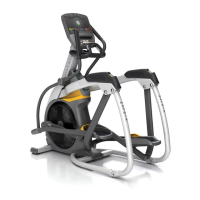13
PROPER USAGE
This equipment offers a variety of
foot positions. Moving your foot to
the forward most position of the foot
pad increases your step height, which
will create a feel similar to a step
machine. Placing your foot toward
the back of the foot pad decreases
your step height and creates more
of a gliding feel, similar to a smooth
walk or run. Always make sure your
entire foot is secured on the foot pad.
This equipment also allows you to pedal
both forward and backwards to offer a
variation to your workout and to focus
on other major leg muscle groups
such as your hamstrings and calves.
To determine proper workout position, stand on the pedal with
your foot on the center of the pedal. Keep your knees slightly
bent at all times. You should be able to pedal without locking
your knees or shifting your weight from side to side.
POWER INCLINE OPERATION
The Ascent Trainers offer powered incline to add variety to your workouts.
The incline can be adjusted using the buttons on the console.
If the stop button is pressed to pause the program, the incline motor will
remain at its current height. To return the incline to 0%, press GO and
change the incline to 0% before dismounting. If the STOP button is held
for 3 seconds to reset the console, the incline will also return to 0%.
USING THE HEART RATE FUNCTION
The heart rate function on this product is not a medical device. While heart rate grips
can provide a relative estimation of your actual heart rate, they should not be relied
on when accurate readings are necessary. Some people, including those in a cardiac
rehab program, may benefit from using an alternate heart rate monitoring system
like a chest or wrist strap. Various factors, including movement of the user, may affect
the accuracy of your heart rate reading. The heart rate reading is intended only as an
exercise aid in determining heart rate trends in general. Please consult your physician.
PULSE GRIPS
Place the palm of your hands directly on the grip pulse handlebars. Both hands must grip
the bars for your heart rate to register. It takes 5 consecutive heart beats (15-20 seconds)
for your heart rate to register. When gripping the pulse handlebars, do not grip tightly.
Holding the grips tightly may elevate your blood pressure. Keep a loose, cupping hold.
You may experience an erratic readout if consistently holding the grip pulse handlebars.
Make sure to clean the pulse sensors to ensure proper contact can be maintained.
WIRELESS HEART RATE RECEIVER
When used in conjunction with a wireless chest transmitter, your heart rate
can be transmitted wirelessly to the unit and displayed on the console.
Prior to wearing the wireless chest transmitter on your chest, moisten the two rubber
electrodes with water. Center the chest strap just below the breast or pectoral muscles,
directly over your sternum, with the logo facing out. NOTE: The chest strap must be tight and
properly placed to receive an accurate and consistent readout. If the chest strap is too loose,
or positioned improperly, you may receive an erratic or inconsistent heart rate readout.
WARNING!
Heart rate monitoring systems may be inaccurate. Over exercising may result in
serious injury or death. If you feel faint, stop exercising immediately.
Backside of chest strap
Apply moisture here

